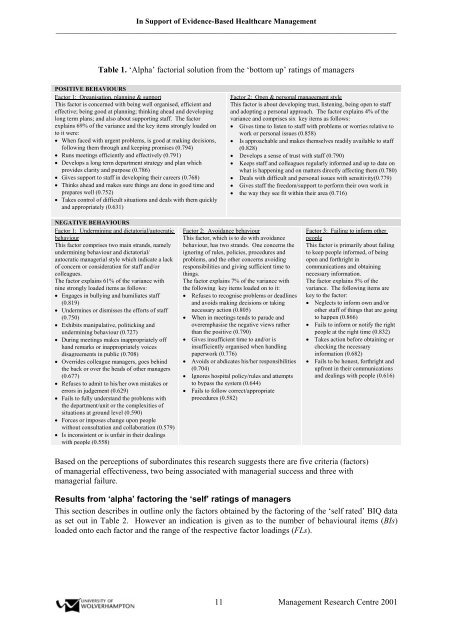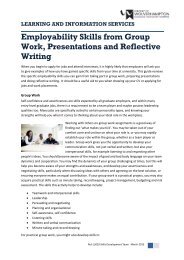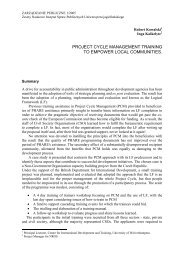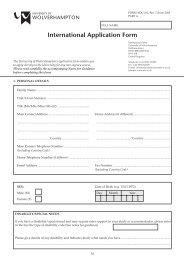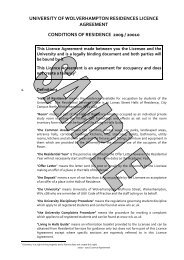In Support of Evidence-Based Healthcare Management: an ...
In Support of Evidence-Based Healthcare Management: an ...
In Support of Evidence-Based Healthcare Management: an ...
- No tags were found...
You also want an ePaper? Increase the reach of your titles
YUMPU automatically turns print PDFs into web optimized ePapers that Google loves.
<strong>In</strong> <strong>Support</strong> <strong>of</strong> <strong>Evidence</strong>-<strong>Based</strong> <strong>Healthcare</strong> <strong>M<strong>an</strong>agement</strong>_________________________________________________________________________________________Table 1. ‘Alpha’ factorial solution from the ‘bottom up’ ratings <strong>of</strong> m<strong>an</strong>agersPOSITIVE BEHAVIOURSFactor 1: Org<strong>an</strong>isation, pl<strong>an</strong>ning & supportThis factor is concerned with being well org<strong>an</strong>ised, efficient <strong>an</strong>deffective; being good at pl<strong>an</strong>ning; thinking ahead <strong>an</strong>d developinglong term pl<strong>an</strong>s; <strong>an</strong>d also about supporting staff. The factorexplains 69% <strong>of</strong> the vari<strong>an</strong>ce <strong>an</strong>d the key items strongly loaded onto it were:• When faced with urgent problems, is good at making decisions,following them through <strong>an</strong>d keeping promises (0.794)• Runs meetings efficiently <strong>an</strong>d effectively (0.791)• Develops a long term department strategy <strong>an</strong>d pl<strong>an</strong> whichprovides clarity <strong>an</strong>d purpose (0.786)• Gives support to staff in developing their careers (0.768)• Thinks ahead <strong>an</strong>d makes sure things are done in good time <strong>an</strong>dprepares well (0.752)• Takes control <strong>of</strong> difficult situations <strong>an</strong>d deals with them quickly<strong>an</strong>d appropriately (0.631)Factor 2: Open & personal m<strong>an</strong>agement styleThis factor is about developing trust, listening, being open to staff<strong>an</strong>d adopting a personal approach. The factor explains 4% <strong>of</strong> thevari<strong>an</strong>ce <strong>an</strong>d comprises six key items as follows:• Gives time to listen to staff with problems or worries relative towork or personal issues (0.858)• Is approachable <strong>an</strong>d makes themselves readily available to staff(0.828)• Develops a sense <strong>of</strong> trust with staff (0.790)• Keeps staff <strong>an</strong>d colleagues regularly informed <strong>an</strong>d up to date onwhat is happening <strong>an</strong>d on matters directly affecting them (0.780)• Deals with difficult <strong>an</strong>d personal issues with sensitivity(0.779)• Gives staff the freedom/support to perform their own work in• the way they see fit within their area (0.716)NEGATIVE BEHAVIOURSFactor 1: Undermining <strong>an</strong>d dictatorial/autocraticbehaviourThis factor comprises two main str<strong>an</strong>ds, namelyundermining behaviour <strong>an</strong>d dictatorial/autocratic m<strong>an</strong>agerial style which indicate a lack<strong>of</strong> concern or consideration for staff <strong>an</strong>d/orcolleagues.The factor explains 61% <strong>of</strong> the vari<strong>an</strong>ce withnine strongly loaded items as follows:• Engages in bullying <strong>an</strong>d humiliates staff(0.819)• Undermines or dismisses the efforts <strong>of</strong> staff(0.750)• Exhibits m<strong>an</strong>ipulative, politicking <strong>an</strong>dundermining behaviour (0.727)• During meetings makes inappropriately <strong>of</strong>fh<strong>an</strong>d remarks or inappropriately voicesdisagreements in public (0.708)• Overrides colleague m<strong>an</strong>agers, goes behindthe back or over the heads <strong>of</strong> other m<strong>an</strong>agers(0.677)• Refuses to admit to his/her own mistakes orerrors in judgement (0.629)• Fails to fully underst<strong>an</strong>d the problems withthe department/unit or the complexities <strong>of</strong>situations at ground level (0.590)• Forces or imposes ch<strong>an</strong>ge upon peoplewithout consultation <strong>an</strong>d collaboration (0.579)• Is inconsistent or is unfair in their dealingswith people (0.558)Factor 2: Avoid<strong>an</strong>ce behaviourThis factor, which is to do with avoid<strong>an</strong>cebehaviour, has two str<strong>an</strong>ds. One concerns theignoring <strong>of</strong> rules, policies, procedures <strong>an</strong>dproblems, <strong>an</strong>d the other concerns avoidingresponsibilities <strong>an</strong>d giving sufficient time tothings.The factor explains 7% <strong>of</strong> the vari<strong>an</strong>ce withthe following key items loaded on to it:• Refuses to recognise problems or deadlines<strong>an</strong>d avoids making decisions or takingnecessary action (0.805)• When in meetings tends to parade <strong>an</strong>doveremphasise the negative views ratherth<strong>an</strong> the positive (0.790)• Gives insufficient time to <strong>an</strong>d/or isinsufficiently org<strong>an</strong>ised when h<strong>an</strong>dlingpaperwork (0.776)• Avoids or abdicates his/her responsibilities(0.704)• Ignores hospital policy/rules <strong>an</strong>d attemptsto bypass the system (0.644)• Fails to follow correct/appropriateprocedures (0.582)Factor 3: Failing to inform otherpeopleThis factor is primarily about failingto keep people informed, <strong>of</strong> beingopen <strong>an</strong>d forthright incommunications <strong>an</strong>d obtainingnecessary information.The factor explains 5% <strong>of</strong> thevari<strong>an</strong>ce. The following items arekey to the factor:• Neglects to inform own <strong>an</strong>d/orother staff <strong>of</strong> things that are goingto happen (0.866)• Fails to inform or notify the rightpeople at the right time (0.832)• Takes action before obtaining orchecking the necessaryinformation (0.682)• Fails to be honest, forthright <strong>an</strong>dupfront in their communications<strong>an</strong>d dealings with people (0.616)<strong>Based</strong> on the perceptions <strong>of</strong> subordinates this research suggests there are five criteria (factors)<strong>of</strong> m<strong>an</strong>agerial effectiveness, two being associated with m<strong>an</strong>agerial success <strong>an</strong>d three withm<strong>an</strong>agerial failure.Results from ‘alpha’ factoring the ‘self’ ratings <strong>of</strong> m<strong>an</strong>agersThis section describes in outline only the factors obtained by the factoring <strong>of</strong> the ‘self rated’ BIQ dataas set out in Table 2. However <strong>an</strong> indication is given as to the number <strong>of</strong> behavioural items (BIs)loaded onto each factor <strong>an</strong>d the r<strong>an</strong>ge <strong>of</strong> the respective factor loadings (FLs).11 <strong>M<strong>an</strong>agement</strong> Research Centre 2001


